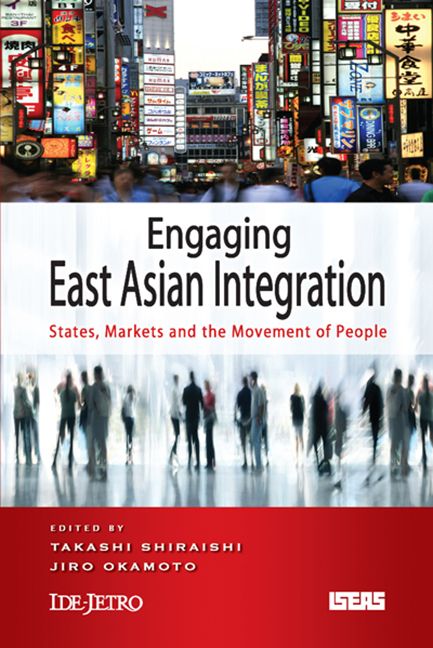1 - Introduction
Published online by Cambridge University Press: 21 October 2015
Summary
The Institute of Developing Economies-Japan External Trade Organization (IDE-JETRO) organized a symposium in December 2008 on the theme, “Engaging East Asian Integration: States, Markets and the Movement of People”. It was held in the wake of the Lehman Brothers collapse and in the midst of the deepening global financial crisis that originated in the United States.
The crisis reminded us of other historic events that marked turning points in the history of East Asian region making. One was the Plaza Accord in 1985 which marked the beginning of the region's economic development and regionalization. The yen appreciated enormously in the wake of the Plaza Accord, forcing Japanese firms — above all, electronics, machinery, and automotive firms — to move abroad and deploy their production facilities regionally to remain competitive in the world market. South Korean, Taiwanese, and Hong Kong as well as Southeast Asian ethnic Chinese business also went transnational and became regionalized. This expansion and deepening of business networks and production chains led to de facto economic integration. It was against this background of regionalization that people such as Mahathir Mohamad, then prime minister of Malaysia, and Takeshita Noboru, prime minister of Japan, started to talk about East Asia as we do now when referring to the region extending from Japan and South Korea through China, Taiwan, and Hong Kong to Southeast Asia. It was also in those years that China transformed itself from socialism to a socialist market economy while being integrated into the regional and global economy.
A crisis that marked another turning point in the history of East Asia was the Asian economic crisis in 1997–98. In the midst of this crisis, the first ASEAN plus 3 (Japan, China and South Korea) summit meeting was held in 1997. The summit meeting was institutionalized in 1998, which also saw the establishment of an East Asia Vision Group to map out the future of the region. A year later, in 1999, the Chiang Mai Initiative laid the foundation for currency cooperation at the bilateral level among states in the ASEAN plus 3. Through these steps, there emerged a regional political project of building an East Asia community in the wake of the 1997–98 Asian economic crisis, in part to create a mechanism for regional cooperation, especially in currency, as a hedge against the kind of U.S.
- Type
- Chapter
- Information
- Engaging East Asian IntegrationStates, Markets and the Movement of People, pp. 1 - 10Publisher: ISEAS–Yusof Ishak InstitutePrint publication year: 2012



